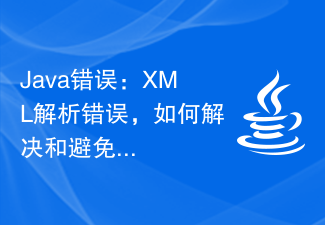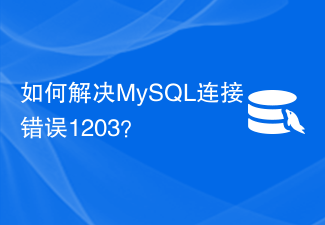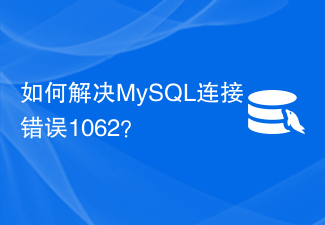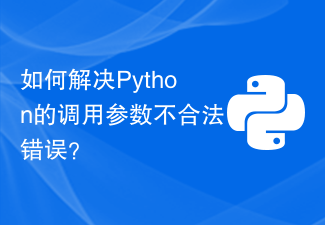
How to solve C runtime error: 'accessing null pointer'?
Introduction:
C is a powerful and widely used programming language, but when writing code, we often encounter various errors. One of them is the "accessing null pointer" runtime error, also known as NUll pointer access error. This article will describe how to resolve this error and provide some code examples to help readers understand better.
What is a NUll pointer access error?
The NULL pointer is a pointer to a null address. When we try to access the memory location pointed to by the NULL pointer, a runtime error of "accessing null pointer" will occur. This error often causes the program to crash or produce unpredictable results.
Solution:
- Check if the pointer is null:
Always check if the pointer is null before accessing it. You can use conditional statements such as if statements to check the value of a pointer. Here is an example:
int* ptr = nullptr; // NULL指针
if(ptr != nullptr) {
// 访问指针
// ...
} In the above example, we initialized a pointer ptr using nullptr and then used a conditional statement to check if the pointer is null. It is only safe to access a pointer if it is not null.
- Initialize pointer:
When declaring a pointer variable, always initialize it to a known legal value rather than leaving it uninitialized. Here is an example:
int* ptr = nullptr; // 初始化为NULL指针
or
int* ptr = new int(10); // 初始化为指向整数的指针
In the above example, we used nullptr to initialize the pointer ptr, or use new The operator dynamically allocates an integer and initializes the pointer ptr to point to it.
- Avoid dangling pointers:
A dangling pointer refers to a pointer that still exists after the pointer is released or the object it points to is destroyed. Dangling pointers are a common cause of 'accessing null pointer' errors. Make sure to set the pointer to NULL or nullptr after releasing the pointer or ending the object's lifetime to avoid dangling pointer errors. Here is an example:
int* ptr = new int(10); // 分配内存 // 在使用指针之后释放它 delete ptr; ptr = nullptr; // 将指针设置为空
In the above example, we have allocated memory for the pointer using new operator and after using the pointer use deleteRelease it. We then set the pointer to NULL to avoid dangling pointers.
- Use smart pointers:
The C standard library provides smart pointers that can automatically manage the life cycle of objects and automatically release memory when it is no longer needed. Using smart pointers can greatly reduce the possibility of NUll pointer access errors. Here is an example:
#include <memory> std::shared_ptr<int> ptr = std::make_shared<int>(10); // 使用shared_ptr智能指针
In the above example, we use the std::make_shared function to create a shared_ptr smart pointer, which will be Automatically free memory when no longer referenced and ensure that NULL pointer access errors do not occur.
Conclusion:
The 'accessing null pointer' error is one of the common errors in C program development. To avoid this error, we should always check if the pointer is null, initialize pointer variables, avoid dangling pointers, and use smart pointers to manage the lifetime of objects. By taking these precautions, we can effectively solve the 'accessing null pointer' error and improve the stability and reliability of the program.
Reference:
- Cplusplus.com. "Null-pointers"
- GeeksforGeeks.org. "Null Pointers in C/C "
The above is the method to solve the C runtime error: 'accessing null pointer'. I hope it will be helpful to readers. It is normal to encounter errors in programming. It is important to learn to solve them and further improve your programming skills.
The above is the detailed content of How to solve C++ runtime error: 'accessing null pointer'?. For more information, please follow other related articles on the PHP Chinese website!
 PHP Fatal error: Call to undefined function mime_content_type()的解决方法Jun 23, 2023 am 08:42 AM
PHP Fatal error: Call to undefined function mime_content_type()的解决方法Jun 23, 2023 am 08:42 AMPHPFatalerror:Calltoundefinedfunctionmime_content_type()的解决方法在进行一个PHP项目的开发过程中,有些时候会经常遇到这种问题——“PHPFatalerror:Calltoundefinedfunctionmime_content_type()”,这个错误一般会在使用PHPM
 Java错误:Eclipse错误,如何解决和避免Jun 25, 2023 am 09:09 AM
Java错误:Eclipse错误,如何解决和避免Jun 25, 2023 am 09:09 AMJava作为一种非常强大和流行的编程语言,被广泛应用于各种计算机应用和开发领域。在编写Java代码时,经常会遇到各种错误信息,这些错误信息可能会影响代码的正常编译和运行。其中,Eclipse是一种广泛使用的集成开发环境,而在Eclipse中遇到错误也是相当常见的。本文将探讨一些常见的Eclipse错误,并提供解决和避免这些错误的方法。一、常见的Eclipse
 Java错误:XML解析错误,如何解决和避免Jun 24, 2023 pm 05:46 PM
Java错误:XML解析错误,如何解决和避免Jun 24, 2023 pm 05:46 PM随着Java在互联网领域中的应用越来越广泛,很多开发者可能会在使用XML进行数据解析的过程中遇到“XML解析错误”的问题。XML解析错误是指在使用Java解析XML数据时,由于数据格式不正确、标签未闭合或者其他原因导致程序无法正常解析数据,从而引发错误和异常。那么,在面对XML解析错误时,我们应该如何解决和避免呢?本文将对这一问题进行详细说明。一、XML解析
 如何解决Python的函数中的硬编码错误?Jun 25, 2023 pm 08:15 PM
如何解决Python的函数中的硬编码错误?Jun 25, 2023 pm 08:15 PM随着Python编程语言的广泛应用,开发者们常常会在编写程序过程中遇到“硬编码错误”的问题。所谓“硬编码错误”,指的是将具体的数值、字符串等数据直接写入代码中,而不是将其定义为常量或变量。这一做法存在多方面的问题,比如可读性低,难维护、修改和测试,同时也会增加出错的可能性。本篇文章就如何解决Python函数中的硬编码错误这一问题进行探讨。一、什么是硬
 如何解决MySQL连接错误1203?Jun 30, 2023 am 11:33 AM
如何解决MySQL连接错误1203?Jun 30, 2023 am 11:33 AMMySQL连接错误1203,如何解决?MySQL是一种广泛使用的关系型数据库管理系统,但是在使用MySQL时,一些连接错误可能会出现。其中一个常见的错误是错误代码1203,它表示数据库连接已中断。在遇到这个错误时,可以采取一些措施来解决问题。首先,我们需要确定错误1203的确切原因。这个错误通常是由于连接超时或连接过多引起的。连接超时可能是由于数据库服务器负
 如何解决MySQL连接错误1062?Jun 30, 2023 pm 05:00 PM
如何解决MySQL连接错误1062?Jun 30, 2023 pm 05:00 PMMySQL连接错误1062,如何解决?MySQL是一种常用的关系型数据库管理系统,广泛应用于各种软件开发和数据存储场景中。在使用MySQL的过程中,我们有时会遇到各种错误,其中一个常见的错误是连接错误1062。本文将介绍这个错误的原因以及解决方法。首先,我们需要了解连接错误1062的含义。连接错误1062通常意味着在执行插入操作时,违反了表的唯一约束条件。在
 Java错误:NetBeans错误,如何解决和避免Jun 25, 2023 pm 06:50 PM
Java错误:NetBeans错误,如何解决和避免Jun 25, 2023 pm 06:50 PM在Java编程中,一个常见的问题就是在使用NetBeans时遇到各种各样的错误。这些错误可能会导致开发者的进度受阻,甚至无法执行程序。在本文中,我们将分享一些常见的NetBeans错误以及如何解决和避免它们。"NetBeans无法启动/打开"错误这是最常见的错误之一,可能是由于许多原因引起的,例如NetBeans已经打开、Java未安装或配置文件已被损坏。为
 如何解决Python的调用参数不合法错误?Jun 24, 2023 pm 10:44 PM
如何解决Python的调用参数不合法错误?Jun 24, 2023 pm 10:44 PMPython是一种高级编程语言,广泛应用于科学计算、数据分析、自动化、Web开发等领域。在Python应用开发中,调用参数不合法错误是一种常见的编程错误,可能会导致程序崩溃或运行结果与预期不符。本文将介绍Python调用参数不合法错误的原因,以及如何解决这种错误。一、Python调用参数的方式在Python中,函数和方法的调用方式有两种:位置参数调用方式位置


Hot AI Tools

Undresser.AI Undress
AI-powered app for creating realistic nude photos

AI Clothes Remover
Online AI tool for removing clothes from photos.

Undress AI Tool
Undress images for free

Clothoff.io
AI clothes remover

AI Hentai Generator
Generate AI Hentai for free.

Hot Article

Hot Tools

SecLists
SecLists is the ultimate security tester's companion. It is a collection of various types of lists that are frequently used during security assessments, all in one place. SecLists helps make security testing more efficient and productive by conveniently providing all the lists a security tester might need. List types include usernames, passwords, URLs, fuzzing payloads, sensitive data patterns, web shells, and more. The tester can simply pull this repository onto a new test machine and he will have access to every type of list he needs.

MinGW - Minimalist GNU for Windows
This project is in the process of being migrated to osdn.net/projects/mingw, you can continue to follow us there. MinGW: A native Windows port of the GNU Compiler Collection (GCC), freely distributable import libraries and header files for building native Windows applications; includes extensions to the MSVC runtime to support C99 functionality. All MinGW software can run on 64-bit Windows platforms.

SublimeText3 Mac version
God-level code editing software (SublimeText3)

SAP NetWeaver Server Adapter for Eclipse
Integrate Eclipse with SAP NetWeaver application server.

Zend Studio 13.0.1
Powerful PHP integrated development environment






